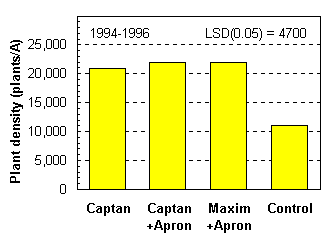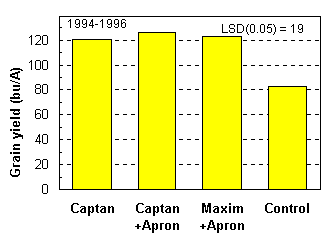December, 1997
Field Crops 28.425-17
Managing Corn Seed Decay And Seedling Blight In Reduced Tillage Systems
Joe Lauer, Corn Agronomist
The trend among Wisconsin farmers is towards earlier planting dates and increased
corn acreage where corn is planted into reduced tillage seedbeds. Consequently,
the seed environment is often cool and wet, and the corn seedling is developing
under conditions that predispose it to pathogen attack. Many agronomists have described
early plant growth under these stressful conditions as "slow-growth" syndrome.
Field symptoms usually include delayed emergence, poor seedling growth, and difficult
stand establishment.
Environments which favor seedling disease have high enough temperatures to start
corn germination followed by a period of low temperatures (Dickson and Holbert,
1928; Dickson, 1929). Many plant pathogens, like Pythium, have optimum pathogenicity
at 7 to 12 C, while corn grows and develops slowly in this temperature range. Leach
(1947) observed "… that other factors being constant, the relative growth rates
of the host and pathogen determine to a considerable degree the severity of preemergence
and seedling infection at different temperatures."
Captan was introduced in 1953 as a seed treatment for corn (Pedersen, 1986). Nearly
all of the corn seed planted in the U.S. is treated with Captan, and over the years
it has been effective at controlling numerous soil pathogens. Recently other fungicides,
Maxim and Apron have been developed that control soil pathogens affecting corn seedling
disease (Table 1).
Our objective was to evaluate the fungicides Captan, Maxim and Apron under reduced
tillage and early planting conditions.
|
Table 1. Efficacy of corn seed treatments
|
|
Disease
|
Captan
|
Maxim
|
Apron
|
|
Rhizoctonia
|
Good
|
Good
|
Poor
|
|
Fusarium
|
Good
|
Excellent
|
Poor
|
|
Pythium
|
Poor
|
Poor
|
Excellent
|
|
Helminthosporium
|
Good
|
Good
|
Poor
|
|
Penicillium
|
Good
|
Good
|
Poor
|
|
Aspergillus
|
Good
|
Good
|
Poor
|
|
derived from Pedersen, U. of Illinois
|
Materials and Methods
Experiments were conducted between 1994 and 1996 at the University of Wisconsin
Agricultural Research Station near Arlington, WI. Plots were established on fields
where corn was grown the previous year. Corn management practices were typical of
those used commercially in the north central region of the United States.
The factors in the experiment were tillage system, hybrids differing in seedling
vigor, and seed treatments. Tillage systems used a John Deere model 7000 corn planter
(Moline, IL). When corn was planted with minimal residue disturbance (i.e. residue
retained), the planter was equipped with a single unit-mounted 13-wave coulter that
was positioned directly in front of the seed disk openers. When residue was removed
from the row area at planting (i.e., residue cleared), three 13-wave coulters and
unit-mounted, notched-disk row cleaners were positioned directly in front of the
seed disk openers. Reasonable attempts were made to ensure that notched-disk row
cleaners cleared residue with minimal soil movement. Any movement of residues back
into cleared strips by wind or rain following planting was not corrected.
Hybrids used were Pioneer 3556 and Pioneer 3475 and were selected for differences
in seedling vigor.
Seed treatments included an untreated control, Captan, Maxim (fludioxonil), Apron
(metalaxyl).
Plots were established on 21 April 1994, 25 April 1995, and 24 April 1996 at a seeding
rate of 32,000 seeds per acre. Seed was planted 1.5 inches deep in rows 30 inches
apart. Dry starter fertilizer was applied through the planter in a band to the side
and below the seed. Additional N was applied in solution injected between rows at
planting. The total N fertilizer rate of over 170 lb. N per acre (starter plus side-dress
N), although considered to be in excess of corn requirements for the yields obtained,
was chosen to reduce the likelihood of N availability influencing corn response
to treatments.
Depending upon year, weeds were controlled using the herbicides cyanazine (Bladex
90DF), and metolachlor (Dual) or alachlor (Lasso) were applied preemergence in a
tank mix. Nicosulfuron (Accent SP), bromoxynil (Buctril 4EC), bentazon (Basagran)
were applied postemergence to control broadleaf and grass weed escapes. In addition,
plots were hand weeded to control escape weeds. Chlorpyrifos (Lorsban 15G) was applied
in a band over the row to control corn rootworm.
Results and Discussion
The field sites selected for these experiments had been in continuous corn with
high amounts of residue on the soil surface. The sites in 1995 and 1996 had a northern
aspect. A high amount of disease pressure was present at the sites.
No tillage or hybrid interactions were observed with seed treatments. Early seedling
vigor of the hybrids was not related to grain yield.
The untreated control had only 34% of the seed emerge (Fig. 1). Plots with seed
treated with fungicide had 66% emergence. No differences were observed for stand
establishment between Captan alone or the combination of Apron with either Captan
or Maxim. No treatments involved Maxim alone.

Numerous growth and development measurements were taken on plants 2 to 3 weeks after
emergence (data not shown). No consistent differences were observed for leaf development,
plant growth, root growth, and root number. It seems that if the plant can become
established and emerge, then growth and development proceeds normally. The largest
effect was a reduction in plant density, which later affected grain yield.
Grain yield response to the seed treatments followed the plant density response
(Fig. 2). Treating corn seed with a fungicide increased grain yield by 50% over
the untreated control. No yield differences were observed among the seed treatments.

In conclusion, there is still room for improvement. Seed treatment is necessary.
Only 60% of the planted seed emerged under these reduced tillage conditions. Captan
alone or Captan in combination with Apron performed similarly to the Maxim and Apron
combination. All corn seed treatments increased grain yield by 50% over the untreated
control.
References
Dickson, J.G. 1929. Influence of soil temperature and moisture on the development
of the seedling-blight of wheat and corn caused by Gibberella sanbinetti.
J. Agric. Res. 23:837-870.
Dickson, J.G., and J.R. Holbert. 1928. The relation of temperature to the development
of disease in plants. Amer. Nat. 62:311-333.
Leach, L.D. 1947. Growth rates of host and pathogen as factors determining the severity
of preemergence damping-off. J. Agric. Res. 75:161-179.
Pedersen, W.L., J.M. Perkins and D.G. White. 1986. Evaluation of Captan as a seed
treatment for corn. Plant Disease 70:45-49.